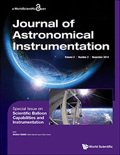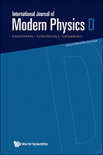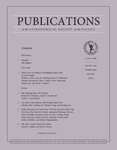
Romanian Astronomical Journal
Scope & Guideline
Elevating the discourse in Astronomy and Astrophysics.
Introduction
Aims and Scopes
- Astronomical Observations and Data Analysis:
The journal publishes papers focusing on observational astronomy, including the analysis of light curves, astrometry, and photometric studies of celestial bodies, which are crucial for understanding their properties and behaviors. - Astrophysical Modeling and Simulations:
Research that involves theoretical modeling of astronomical phenomena, such as gravitational interactions, dark matter dynamics, and the behavior of celestial bodies under specific conditions, is a core focus area. - Astro-Geodesy and Geoid Modeling:
The journal emphasizes studies that integrate geodesy with astronomy to enhance the understanding of Earth's shape and gravitational field, which are vital for satellite navigation and positioning. - Educational Approaches in Astronomy:
Papers discussing innovative teaching methods and case studies in astronomy education highlight the journal's commitment to improving educational practices within the field. - Technological Advancements in Astronomy:
The journal showcases advancements in astronomical instrumentation and technology, including developments in satellite simulations and radio telescopes, reflecting the ongoing evolution of the field.
Trending and Emerging
- Machine Learning in Astronomy:
The integration of machine learning techniques for tasks such as asteroid detection and data analysis is gaining traction, highlighting the journal's commitment to embracing innovative computational methods. - Dark Matter and Cosmology Studies:
Research focused on dark matter, particularly in relation to cosmological models and thermodynamic approaches, is trending, underscoring the ongoing quest to understand the universe's fundamental components. - Polarization and Instrumentation Techniques:
The development and refinement of astronomical instruments for polarization measurements and other observational techniques are emerging themes, reflecting advancements in observational capabilities. - Geophysical and Astro-Geodetic Intersections:
There is an increasing focus on the intersection of geophysics and astronomy, particularly in geoid modeling and its implications for satellite technology, indicating a trend towards interdisciplinary research.
Declining or Waning
- Historical and Cultural Astronomy:
Papers focusing on the historical aspects of astronomy and ancient astronomical practices have become less frequent, suggesting a waning interest in this niche area compared to more contemporary scientific inquiries. - Solar System Dynamics and Classical Mechanics:
Although still relevant, studies specifically centered on traditional solar system dynamics and classical mechanics seem to be decreasing, possibly overshadowed by more complex and modern modeling approaches. - Astrophysics of Ancient Astronomical Symbols:
Research exploring the meanings and implications of ancient astronomical symbols has seen a decline, indicating a shift towards more empirical and data-driven studies in modern astronomy.
Similar Journals

ASTROPHYSICS
Navigating Cosmic Frontiers: Your Guide to Astrophysical DiscoveryASTROPHYSICS, published by Springer/Plenum Publishers, stands as a crucial platform for the dissemination of groundbreaking research in the field of Astronomy and Astrophysics. Established in 1965 and continuing its legacy until 2024, the journal highlights significant advancements, theoretical frameworks, and observational data that collectively push the boundaries of our understanding of the universe. Although currently categorized in the Q4 quartile for Astronomy and Astrophysics and holding a Scopus rank within the 17th percentile, ASTROPHYSICS remains dedicated to offering rigorous peer-reviewed content that is essential for researchers, professionals, and students alike. While it does not provide open access, the journal's accessibility through institutional subscriptions ensures a wide reach among the academic community, allowing it to address the rising curiosity surrounding cosmic phenomena and contribute meaningfully to ongoing scholarly discourse. For those seeking to engage with the latest findings and methodologies in astrophysics, ASTROPHYSICS continues to serve as an indispensable resource.

Advances in Astronomy
Pioneering Research in Astronomy and Astrophysics.Advances in Astronomy is a prestigious open-access journal published by HINDAWI LTD, dedicated to the field of astronomy and astrophysics. Established in 2008, the journal aims to disseminate significant research findings and advancements in the understanding of celestial phenomena, planetary sciences, and the intricate workings of the universe. With an impact factor that reflects its relevance in the scholarly community, Advances in Astronomy holds a commendable rank of Q3 in both Astronomy and Astrophysics as well as Space and Planetary Science categories, indicating its importance within these fields. The journal also showcases a commitment to open-access publishing, ensuring that research is readily available to both the scientific community and the public. Researchers, professionals, and students alike are encouraged to contribute to this dynamic forum to share knowledge and foster collaboration in exploring the wonders of the cosmos.

Contributions of the Astronomical Observatory Skalnate Pleso
Fostering Discovery: Where Slovak Research Meets Global AstronomyContributions of the Astronomical Observatory Skalnate Pleso, published by the Slovak Academy of Sciences Astronomical Institute, serves as a vital platform for the dissemination of research in the realm of Astronomy and Astrophysics. With its ISSN number 1335-1842 and E-ISSN 1336-0337, this esteemed journal aims to foster scientific discourse and innovation among researchers, professionals, and students alike. Although it currently holds a Q4 quartile ranking in its field as of 2023, the journal encourages contributions that enhance our understanding of universe dynamics and celestial phenomena through rigorous research methodologies. Spanning from its inaugural year in 2007 to the projected continuation through 2024, it integrates local insights from Slovakia with broader international endeavors in astronomy. The journal promotes an open-access approach, providing scholars unrestricted access to valuable findings and discussions, thereby advancing the boundaries of astronomical knowledge.

NEW ASTRONOMY REVIEWS
Navigating the Heavens: Premier Insights into Space and Planetary ScienceNEW ASTRONOMY REVIEWS, published by Elsevier Science Ltd, stands as a premier journal in the field of Astronomy and Astrophysics as well as Space and Planetary Science. Established in 1998 and operating until 2024, this journal has consistently maintained a distinguished reputation, reflected in its Q1 categorization in both subject areas for 2023. It holds an impressive Scopus ranking, placed #6 out of 104 in Earth and Planetary Sciences and #7 out of 90 in Physics and Astronomy, showcasing its critical impact with a percentile rank of 94th and 92nd, respectively. Although not an open access journal, it provides vital insights and comprehensive reviews that are essential for researchers, professionals, and students eager to advance their knowledge in contemporary astronomical research and theories. With rigorous peer review and a commitment to high-quality publications, NEW ASTRONOMY REVIEWS is an indispensable resource for the scientific community striving to uncover the mysteries of the universe.

Journal of Astronomical Instrumentation
Connecting Research and Technology in the World of AstronomyThe Journal of Astronomical Instrumentation, published by WORLD SCIENTIFIC PUBL CO PTE LTD, is a pioneering peer-reviewed journal that has established itself as a vital outlet for the dissemination of research in the fields of astronomy and astrophysics, as well as in instrumentation technologies. Since its inception in 2012, this international journal has provided a platform for researchers and practitioners to share their findings, innovations, and insights pertaining to astronomical tools and techniques. With an esteemed Q3 categorization in both Astronomy and Astrophysics and Instrumentation for 2023, it ranks within the top tier of journals in these disciplines, demonstrating its impact and relevance in the scholarly community. Covering a broad range of topics that encompass the design, development, and application of astronomical instruments, the journal also emphasizes technological advancements that enhance observational capabilities. Researchers, professionals, and students alike will find this journal an invaluable resource for staying abreast of current trends and breakthroughs in the field of astronomical instrumentation.

Journal of the Korean Astronomical Society
Charting New Frontiers: The Pulse of Astronomical ResearchWelcome to the Journal of the Korean Astronomical Society, an esteemed publication dedicated to advancing the fields of Astronomy and Astrophysics as well as Space and Planetary Science. Established in 1993 and under the reputable auspices of the Korean Astronomical Society, this journal serves as a vital platform for researchers and scholars from South Korea and around the globe to disseminate innovative findings and critical insights. With a commendable Q2 ranking in Astronomy and Astrophysics and a Q3 ranking in Space and Planetary Science, this journal is positioned among the influential voices in its fields, fostering collaboration and knowledge exchange. The journal's rigorous peer-review process ensures that published works contribute significantly to ongoing discussions and developments in astronomical research. While currently not an open-access journal, it remains accessible to the academic community, encouraging readers to stay abreast of the latest advancements in the sciences that elucidate the universe's complexities. Join us in exploring the cosmos through cutting-edge research and scholarly discussion that propels the field forward.

Journal of Astronomical History and Heritage
Illuminating the Legacy of AstronomyWelcome to the Journal of Astronomical History and Heritage, a distinguished publication that delves into the fascinating intersections between astronomical science and its historical context. Published by University Science & Technology China (USTC), this journal aims to promote a deeper understanding of how humanity's understanding of the cosmos has evolved over time. With a focused scope that encompasses the historical narratives of astronomy, this journal serves as a pivotal resource for researchers, professionals, and students in the fields of Astronomy, Astrophysics, and History. Although it is currently categorized in the fourth quartile for Astronomy and Astrophysics and in the second quartile for History, the journal holds an impressive rank in the arts and humanities category, reflecting its 88th percentile standing. The journal, which has aggregated notable works from 2019 to 2024, represents a unique platform for innovative scholarship and discussions related to our astronomical heritage. While offering limited access options, it strives to contribute significant knowledge to the field, fostering collaboration and exchange among scholars dedicated to understanding the past as we explore the universe.

INTERNATIONAL JOURNAL OF MODERN PHYSICS D
Elevating Research Standards in Modern PhysicsWelcome to the INTERNATIONAL JOURNAL OF MODERN PHYSICS D, a premier publication dedicated to the advancement of knowledge in the fields of Astronomy and Astrophysics, Mathematical Physics, and Space and Planetary Science. Published by WORLD SCIENTIFIC PUBL CO PTE LTD in Singapore, the journal boasts an impressive impact, being ranked Q2 in Astronomy and Astrophysics and Mathematical Physics, and Q3 in Space and Planetary Science. With a converged publishing timeline from 1996 to 2024, this journal provides a vital platform for researchers and professionals to disseminate their findings, engage with cutting-edge research, and explore emerging ideas in modern physics. Although it operates under a traditional access model, the rigorous peer-reviewed process ensures that only the highest quality research contributes to the collective understanding of our universe. Join us in advancing the frontiers of physics and astronomy!

PUBLICATIONS OF THE ASTRONOMICAL SOCIETY OF THE PACIFIC
Connecting Researchers to the Stars: Your Essential ResourcePublications of the Astronomical Society of the Pacific is a prestigious journal dedicated to advancing the fields of Astronomy and Astrophysics, as well as Space and Planetary Science. Published by IOP Publishing Ltd, this influential journal plays a critical role in disseminating groundbreaking research and innovative findings. With an impressive Q1 ranking in both related categories according to the 2023 metrics, it is recognized among the top journals in its field. As a vital resource for researchers, professionals, and students alike, the journal covers a range of topics relevant to current astronomical research from 1996 to 2024. Although it does not offer open access options, the journal is highly regarded in academic circles, evidenced by its competitive ranking in Scopus—20th in Astronomy and Astrophysics and 26th in Space and Planetary Science. This commitment to excellence ensures that it remains an essential platform for sharing the latest insights in the ever-evolving universe.

Universe
Empowering Researchers to Illuminate the Cosmos.Universe is a distinguished peer-reviewed journal published by MDPI, specializing in the dynamic fields of Physics and Astronomy. Established in 2015, this Open Access journal has rapidly gained recognition, achieving a prestigious Q1 quartile ranking in its category as of 2023. With its E-ISSN 2218-1997, the journal primarily serves the international scientific community, offering a platform for researchers to disseminate innovative ideas and findings. Based in Switzerland, Universe covers a wide range of topics within astronomy and astrophysics, ensuring that cutting-edge research is accessible to an ever-growing audience. Its commitment to open access principles since its inception allows for unrestricted dissemination of knowledge, fostering a collaborative environment essential for scientific advancement. By aligning its objectives with the promotion of high-quality research and interdisciplinary discourse, Universe stands as a vital resource for academics, professionals, and students aiming to contribute to and engage with the ever-evolving landscape of astronomical research.